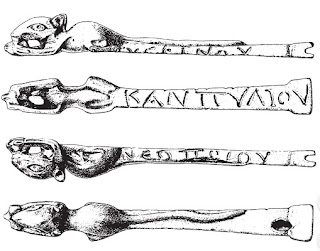 |
| Greek Alive and Well on the Strand! |
To provide some context, the two-term Beginners’
Greek class at Oxford University’s Dept. for Continuing Education is advertised as costing 'From £373.00'. This week I
received a request to join my initiative from an East End Pensioner who had to
give up the Greek classes at CityLit because s/he can’t afford the £169 per
term as well as feed the cat. I accepted.
 |
| With Co-Author Henry at Victoria Station |
Albert Mansbridge, who later founded the
Workers’ Educational Association, had taken Extension courses at my own King’s
College London. Many London professors gave up time to teach the proletarian
students at Toynbee Hall. At Leeds, Prof. Rhys Roberts organised archaeology
and classics classes for local working men in the 1910s. It was the QUB Professor
of Latin, Robert Mitchell Henry, who almost single-handedly founded the Belfast Workers’ Educational Association in
1910; 56 local people took his first course on ‘Roman Social Life Under
the Early Empire’.
 |
| Katherine Glasier, Newnham Extension Tutor |
Joe Guy, a miner from Sacriston, in 1952
studied Greek on a course set up by the National Union of Mineworkers and
Durham Colleges’ Board of Extra-mural Studies.
The Durham University Extension Lectures aimed ‘to bring some of the
benefits of University teaching within the reach of persons, of either sex and
of every class, who have been unable to join the University as Matriculated
Students’. In 1916 the extra-mural
teaching was directed by Revd. E.G. Pace, whose ambition was 'to interest more pitmen in Extra-mural work’.
In the late 1940s, Walter
Taylor’s extra-mural Social History course covered the Roman Occupation of
Durham County, and his evening classes (1957-8), entitled Archaeology and
History of Roman Britain, were well attended at Billingham Technical
College. One H.W. Harbottle taught Ancient
History from 1954-56, in the pit communities of Langley Park and
Chester-le-Street.
We could do this again, for free. We CAN
fight back against the disgusting commercialisation of our universities, whose over-riding imperative is
now to make enough money to pay the ludicrous salaries of the talentless
management class. It is disgraceful that so few Higher Education organisations today
pay serious attention to the provision of cost-free education for the less
privileged members of society.

Aristotle, who taught the public in the afternoons, says that tyrants always shut down community reading groups because they foster the critical thinking and social bonds which will always, ultimately, destroy tyranny. He was right. Let’s Make British Universities Really Matter Again!

Aristotle, who taught the public in the afternoons, says that tyrants always shut down community reading groups because they foster the critical thinking and social bonds which will always, ultimately, destroy tyranny. He was right. Let’s Make British Universities Really Matter Again!






